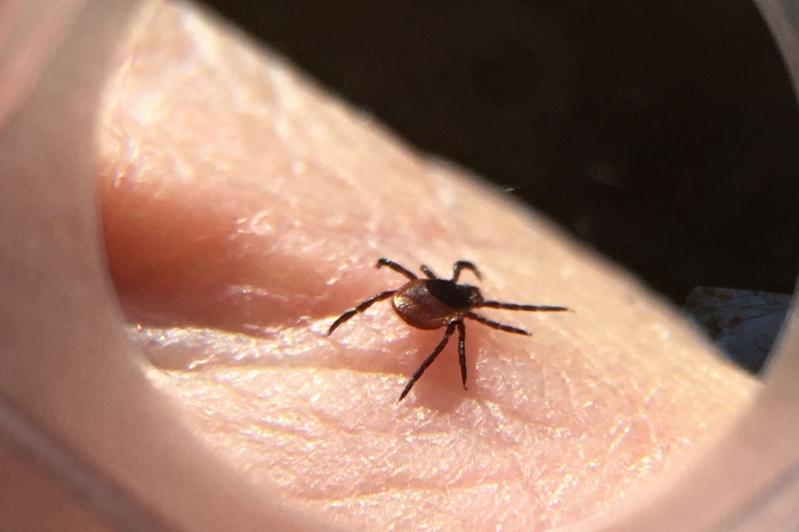An East Hampton medical practice is participating in a research project aimed at accelerating medical breakthroughs for Lyme disease, the most common vector-borne infectious disease in the United States and one of several illnesses that can be transmitted by an infected tick.
East Hampton Family Medicine announced a call to action last month, asking that people experiencing symptoms of early-stage Lyme disease donate a small blood sample and fill out forms reporting their symptoms. These will become part of the Bay Area Lyme Foundation's Lyme Disease Biobank, which provides biological samples to researchers exploring new diagnostics and potential treatments for the often debilitating disease.
Patients will be offered a $50 Amazon gift card in exchange for their participation.
Current diagnostics are inaccurate for more than half of early-stage Lyme disease cases, according to the Bay Area Lyme Foundation. A study using samples collected by the Lyme Disease Biobank and published in the Journal of Clinical Microbiology concluded that the current standard diagnostic test for Lyme disease could not confirm the diagnosis of 71 percent of blood samples from individuals in endemic areas presenting with a Lyme rash.
Awareness of the danger of Lyme disease was reaffirmed on the South Fork last weekend with the death of Elisabeth Kieselstein Cord Hamm, an artist and socialite who frequented Southampton. Her death, at 41, is believed to be related to complications from Lyme disease.
Dr. George Dempsey, the medical director of East Hampton Family Medicine, said last week that a biobank, a repository that stores biological samples for research purposes, represents an efficient means of carrying out research. Collecting biological materials from a population provides important data on "a community with all the diversity that you don't get in a research study, where you have a selected group of people that come in," he said last week. "From there, multiple scientists from everywhere can have access, so you get more, and more diverse, research studies out of it."
Dr. Dempsey likened the biobank project to the Framingham Heart Study, a long-term, ongoing study in which blood samples are collected from residents of the Massachusetts city. The study has yielded an extensive understanding of heart disease.
"A lot of it has already gone into developing a lot of different ways of diagnosing Lyme early," Dr. Dempsey said of samples forwarded to the Lyme Disease Biobank, "and it's really advancing our knowledge of the immunology of disease." Research of Lyme disease, he said, is also contributing to other areas of study, with samples collected in East Hampton contributing to new diagnostic analyses on Covid-19.
East Hampton Family Medicine was the first collection site in the United States for the Lyme Disease Biobank, Dr. Dempsey said, having started collection activity in 2014, and it is the biobank's largest contributor of samples. More than 1,000 participants across multiple sites are enrolled at present, and more than 65 research projects rely on the biobank's samples.
Additional health information about personal experiences with Lyme disease is also helpful to researchers. The federal Centers for Disease Control and Prevention had a biobank around 20 years, ago, Dr. Dempsey said, which pooled samples from different regions. "But the difference with this one is that we really get into detail characterizing each specimen." East Hampton Family Medicine, for example, forwards to the biobank a photo of the rash that often appears following a tick bite.
"That has not been done before," he said of the quantity and detail of information provided to the biobank. "It gives a lot more clinical information on the patient, so that each sample has a lot of information about it, which scientists love because they can separate out variables between samples. They know that, when they do a test, variability is controlled, which gives better validity to the research." This methodology, he said, "is, to me, the future of research and science, rather than just the university-based type, where you get your subjects and your biological material to study."
Cases of tick-borne illness typically peak in June and July, Dr. Dempsey said. This year, "we're seeing a lot more babesiosis and ehrlichiosis" along with Lyme disease, all of which can cause severe illness. Ticks' geographic range "has changed tremendously" because of climate change, he said: "They've moved up into Canada."
"What's also happened out here, especially," he said, "is the lone star tick has come in. It wasn't even here about 10 years ago. The lone star, I think, has out-competed the deer tick." Ticks brought to East Hampton Family Medicine by those who have been bitten "are almost all lone star," which carries ehrlichiosis, he said. "Ecological change is affecting the patterns of each disease. It's amazing, the change. Literally, I can hardly remember anyone bringing in a deer tick" this year.
Those experiencing early-stage symptoms of Lyme disease have been invited to call East Hampton Family Medicine at 631-324-9200 to enroll in the biobank. Symptoms of early-stage Lyme disease include flu-like ailments, such as fever or chills, muscle and/or joint pain, headaches, fatigue, and sometimes a skin rash. The latter is commonly, but not always, a circular or expanding bulls-eye rash that spreads from around the original bite area.
The New Yorker magazine reported last month that a vaccine for Lyme disease may be available in two years. The federal Food and Drug Administration approved a pharmaceutical company's Lyme disease vaccine in 1998, but the company abandoned it four years later. Some people who had received the vaccine, The New Yorker reported, came to believe that it caused arthritis, and multiple class-action lawsuits were filed claiming that the company had withheld evidence of the vaccine's dangers.

